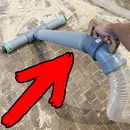Introduction: Fallen Branch Lamp
Give a new life to a fallen tree branch by turning it into an awesome mood light! It is a great way to bring some of nature´s finest design into your home!
Fallen branch lamp as the name suggests is a branch with a light source integrated into it. What makes it special is that you can not find two identical ones, ever! Every lamp is unique and has a very particular feeling to it, sort of telling a story of the tree that it used to be.
This instructable came about after my girlfriend saw the Indoor Lighting contest and suggested that I should do another lamp and show you guys how I did it. I have done a few similar lights in the past and as it really only takes a few hours to make I said why not. I really like these types of lamps because of the different textures and colours they have plus the shadow looks really cool as well! More photos in the final step!
Let`s get started!
PS: The lamp you see in the thumbnail is not the one I am making in this ´ible, but it was made in a very similar manner. I just had a really good picture of it.
The light you see me make here is named "Condumbra" and it is made from Bird Cherry (Prunus padus). It is actually for sale so send me a private message if you are interested!
Step 1: What You Will Need!
The only materials you will need are:
- A retro LED light bulb*
- A light socket
- An electrical cord with a switch
- A can of spray lacquer
Tools you will need are:
- A hand saw
- A pointy tool like a chisel
- Small screwdriver
- A glue gun
- Sanding block
- Drill and a drill bit
- Non-woven abrasive pad
Of course, the possibilities are endless with this project. You could add all the bells and whistles you can come up with.
On the lamp with a really big bulb, I also decided to add a dimmer switch. It is a great way to adjust the light for the mood you have! Two important things you have to remember when adding a dimmer is that the LED bulb has to be dimmable and the dimmer itself has to be rated for LED-bulb.
*Use LEDs because they are much more efficient and do not give out so much heat. Wood and heat work well in a wood burner but not so well in the corner of your room!
Step 2: Source the Wood!
This is the fun part (and a really good excuse to go on a long hike in the forest)!
A good place to look for a fallen branch is near old trees. The goal is to find a branch that is hollow due to rotting. A great time for scavenging is right after a big storm (for obvious reasons).
As you can see I took home quite a few branches. For this project, I chose what I believe was Bird Cherry (Prunus padus). I found it near a small road in the bush. I will turn the rest of the branches into indoor lightings in the future.
The next step is to clean the branch a little. A really good tool for this is compressed air. With the long nozzle air blow gun, the removing of the dust will go like a breeze(pun intended). Of course, most of us do not have such tools at home so other options would be long pointy tools like chisels. Try to remove as much loose material as possible without making it obvious that nature was not the only designer of this lamp.
Step 3: Make It Stand Up!
This is the only tricky part! If your branch is long and thin then it probably needs to be really well balanced for it to stand up on its own. Visually mark a line that would allow the branch to stand upright and make the cut leaving a little extra for errors. It might not be perfect on the first try but this is where a coarse sanding block comes handy. Use it to do fine adjustments. If your branch does not show any signs of standing up at all make another cut or use a rasp to do adjustments.
You know you finally got it right when the branch is standing upright without rocking in any direction and the bottom edge touches the floor all around!
Step 4: Sparks......hopefully Not!
Ahh, the wiring! Intimidating but it should not be!
Here where I live (Europe) wires come in three colours - brown for phase, blue for neutral and yellow-green for ground. The cord that I bought only had brown and blue. Light sockets rarely have a place for a ground wire. If your cord came with the ground wire I suggest you isolate it with some tape and leave it be.
But where should I attach the brow and the blue wire? Well, it does not really matter (unless indicated otherwise). Light bulbs (just like most electrical appliances) do not care which way you connect them to the power. This is also why you can also plug stuff into power outlets either way.
Correction!
It does make a difference where the wire goes. The National Electrical Codes requires that the neutral wire is connected to the screw shell and the hot wire is tied to the center contact in the center of the socket. The reason for this is that when screwing or unscrewing the bulb, if the hot wire or switched wire is connected to the screw shell, it is possible that if you touched the thread on the bulb you could be shocked. The light will work either way, but this is the proper way to connect a socket.
Thank you edingtony and Serdahely for pointing out my mistake!
My light socket had two screws for fixing the wires in place. Yours might be the same or have some sort of clip-in method. The principles stay the same!
I also suggest hot glueing the metal parts (where the wires connect to the socket, of course) of the light socket. This will ensure no one gets electrocuted accidentally and it will not come loose so easily when pulled.
Step 5: Attach the Socket!
Create a hole for the cord using a drill. It is important to do it before wiring the socket because you have put the cord through the hole first! If you do not have a drill then you could alternatively fiddle a little groove for the cord using a knife.
Dry fit the socket to see where you want to glue it. Do it with a light bulb attached to see if it will actually fit and look straight. Chisel out some wood (if needed) to make it fit better.
If you are happy with the looks add glue. Also, glue down the wire inside the lamp if possible.
Tip: The key to glue gun longevity is to let it heat up properly - like 5 minutes at least. I have gone through so many glue guns because I´ve attempted pressing glue sticks through a cold glue gun.
Step 6: Time for Some Varnish!
Woah, not so fast!
First grab a non-woven abrasive pad and clean of any dust and other loose particles! Cover the plug with some paper and do same with the cord (using masking tape). Give the whole thing a final blow with compressed air and you are ready for some varnish!
Follow the instructions on the spray can! Use respiratory protection or do it outside as I did. Two coats are enough.
Step 7: The End!
And that is it! This is all it takes to turn something designed by mother nature into awesome home decore. I can guarantee you that your lamp will become a conversation piece!
If you have any questions or suggestions please leave them down in the comments!
Happy making!
Andu
PS: I would love if you voted for me in the Indoor Lighting contest! Thanks

Participated in the
Indoor Lighting Contest













